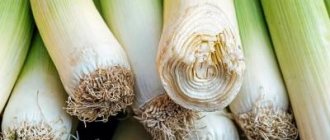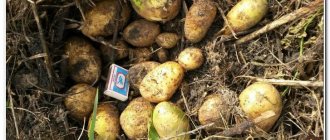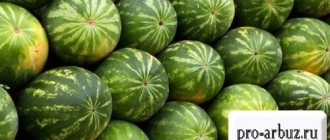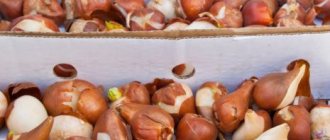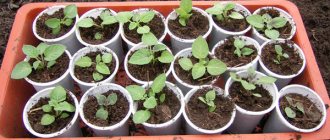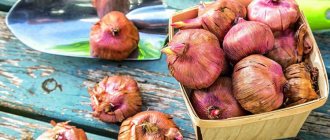Rules and conditions for storing seed material
Experts recommend adhering to the following rules when storing seed potatoes:
- Dry and prepare the tubers well.
- Before laying, gradually reduce the temperature in the drying area.
- At the end of February or the beginning of spring, warm the seeds at a temperature of +14...+17°C so that they awaken after vegetative dormancy.
- Before planting, sort through the tubers again and remove damaged specimens.
During storage, temperature changes should not be allowed, as this shortens the dormant period of the planting material.
Dependence of variety and storage temperature
The choice of optimal temperature depends on the plant variety.
Attention! Deviation from recommended standards increases seed losses during storage.
A decrease in temperature negatively affects seed quality, and an increase leads to the germination of tubers and the development of diseases.
How to select the right seed potatoes for planting
Seed potatoes in the photo
In your individual farm, it is recommended that 15-20% of the total area occupied by potatoes be allocated to a seed plot. Potato tubers for future planting in this area should be planted thickly (nutrition area 70×25 cm, 70×20 cm) in order to obtain a greater yield of seed tubers.
On the seed plot, it is necessary to carry out 2-3 variety and phytocleansing. The first is carried out at a plant height of 11-13 cm, the second - during the period of mass flowering, when varietal impurities are clearly expressed and signs of major diseases will be indicated. Varietal impurities are most easily distinguished by the color of the flower, since the flower is the richest in varietal distinctive characteristics. It is advisable to carry out a third cleaning - 3 weeks before harvesting, but before the tops dry out. Sick plants and varietal impurities should under no circumstances be pulled out of the ground and left between the rows. These plants must be dug up along with the tubers, lightly shake off the soil, and then put them in a basket or bag. When the container is full, it must be taken to the edge of the site, where the “culling” must be destroyed, in particular by burning.
Before harvesting seed potato tubers, colored rags must be tied to powerful, selected, well-developed bushes. When carrying out subsequent harvesting for seeds, tubers should be selected only from marked plants.
In the seed plot, 10-14 days before mass harvesting, it is necessary to remove the tops, which will help increase the yield of the seed fraction.
The tops are removed either by mowing or in large areas by desiccation (removal using chemicals). In the latter case, 15 days before harvesting, use 20% Reglon at a dose of 2 l/ha or an aqueous solution of magnesium chlorate - 15-20 kg/ha when spraying 300 l/ha.
Destruction of tops by mowing is both harmful and ineffective: in wet weather they grow back again, and this will lead to depletion of the tubers of the new crop, and secondly, if one or another infection, in particular late blight, “walked” on the tops, then this can lead to possible infection of the tubers.
When desiccating, the drug acts effectively at an air temperature of 15-17 ° C, while under the influence of the desiccant the tops dry out, plastic substances pass into the tubers (which leads to an increase in the yield and quality of tubers by 20-30%), the integumentary tissue on the tuber skin becomes corked and becomes durable, thereby increasing its keeping quality.
Rules for selecting seed potatoes
It is recommended to select planting material in the summer, when the vegetable crop is still blooming. Select and mark healthy and strong bushes. The tubers of such plants have good heredity. They are larger in size and disease resistant.
When selecting potatoes for seeds from under such bushes, adhere to the following rules:
- Avoid small tubers, as this contributes to the degeneration of the variety.
- Choose plants under which about 8-10 tubers have grown (half of them are large).
- The weight of seed potatoes reaches 100 g (the size of a goose egg). If possible, larger planting material is also selected.
- Potatoes should not be left for seed if rotten or diseased specimens were found in the bush. This vegetable is infected with a fungal disease.
All selected tubers are carefully examined to exclude the presence of damage, spots of rot and signs of disease.
Analysis of seed potatoes before storage
Inspecting tubers to identify various diseases and rotting allows you to determine whether the vegetable is suitable for long-term storage or not. To do this, 100 potatoes are placed in two bags with slots and left for 14 days in a dark place. The temperature should be +20…+25 ° C.
The conclusion is made based on the amount of spoiled material. If rot appears on only 20% of the sample or less, then the tubers are sorted and sent for storage. However, if unhealthy potatoes are discovered again during the winter, the batch must be sent for processing. The presence of more than 30% rot indicates that these vegetables are not suitable for wintering and spring planting.
Which varieties are suitable for long-term storage?
Early ripening potato varieties are poorly stored. Such a vegetable quickly becomes lethargic and loses its seed qualities.
The following varieties last well throughout the winter and do not germinate until spring:
- Gala. It has a spherical shape, light flesh and brown skin. The weight of the tuber reaches 120 g.
- Red Scarlett. Bred by Dutch breeders. The tuber is oblong, with a smooth surface. The pulp is white, the skin is red. The average weight of a tuber is 100 g.
- Nevsky. Potatoes are round in shape and yellow in color. When cut, the vegetable is pale cream in color. Grows up to 130 g.
- Picasso. A representative of the Dutch selection has a yellow skin with burgundy splashes. The potato reaches a weight of 120 g, its flesh is cream-colored.
- Crane. Produced in Belarus. The tuber is large, oval in shape, pink in color. Reaches 160 g.
Preparing the cellar
The most suitable place for long-term storage of potatoes and other vegetables is, of course, the cellar. It can be installed in a separate room, subfloor of a house, basement or in an unheated garage.
The cellar is prepared several days before storing supplies. The work consists of the following stages.
- Check the humidity in the room. If the cellar is damp, it needs to be ventilated. You may need to build an additional hood or vent. In any case, the cellar must be dry.
- It is necessary to disinfect and dry containers for storing potatoes: wooden boxes, shelves, barrels and other devices. To do this, they are treated 2-3 times with a strong solution of potassium permanganate, after which they are dried in the sun.
- It would be useful to disinfect the walls of the room using whitewash, for the preparation of which take 2 kg of lime, 1 kg of copper sulfate, 150 g of salt, mix and dissolve in 10 liters of water. The resulting solution is used to treat the room twice with an interval of 7 days.
The more thoroughly the cellar is prepared, the better the potatoes will be stored.
When adding vegetables, you must remember that potatoes should not be kept next to cabbage, onions or carrots. But the proximity to red beets has a beneficial effect on the safety of the tubers. Beets draw moisture away, leaving the potatoes dry.
To store vegetables, nets, bags, special wooden boxes and compartments are used. The main thing is to ensure free air circulation so that the product does not cake, rot or rot.
We recommend: Is it possible to freeze fried minced meat cutlets?
Preparing seed potatoes for storage
Harvested potatoes cannot be stored immediately. The peel of this vegetable is still thin and not ripe enough. To make it denser and minor damage to heal, keep the seed in a well-ventilated place for two weeks.
It is also useful to green the seeds in the light. To do this, the tubers are laid out in one layer and periodically turned over. Daylight encourages the accumulation of corned beef in them. This is a poison, so potatoes become inedible for rodents, and their resistance to diseases increases.
Attention! Such tubers are unsuitable for human consumption.
After drying and ripening, the seed material is carefully inspected again, rejecting damaged specimens. To enhance immunity, the seeds are treated with one of the fungicidal preparations. For this purpose, Maxim or a weak solution of copper sulfate is often used.
When preparing the composition, 2 g of the substance is diluted in one bucket of water. After processing, the potatoes are well dried.
Potato storage methods
The apartment has limited space for long-term storage of large quantities of vegetables. We are not talking about one or two kilograms of potatoes, but several bags or nets. The most optimal temperature is up to 7 degrees. Additionally, you need to maintain the required humidity level (85-90%). Not every room is suitable for placing containers with tubers - it is unlikely that anyone will want to keep food in the living room or bedroom.
Therefore, root vegetables are mainly stored in the kitchen. It's good if you have a spacious pantry. As an option, you can place vegetables in the vestibule of the entrance, leave them on the balcony or loggia, or use the refrigerator. Each method has its pros and cons - you need to take into account all the nuances so that the tubers are stored for a long time.
A convenient storage option is a glass balcony. The unheated loggia maintains an acceptable temperature for storing potatoes on the balcony in winter. If the loggia is not glazed, you need to constantly monitor the temperature outside so that the tubers do not freeze. You can use a wooden box insulated with foam plastic and wrap the container in warm winter clothes. Proper storage of potatoes on the balcony implies that:
- You need to keep vegetables in a box made of wooden material.
- The container with tubers can be wrapped in an old cotton blanket.
- On an uninsulated balcony, boxes with polystyrene foam are needed.
Options for compact placement of containers for potatoes on the loggia
If the loggia for storing potatoes on the balcony in winter is not glazed, it is convenient to use a two-layer method of filling the containers. To do this, take two wooden boxes of different sizes. A layer of sawdust is poured into the bottom of the larger container and a smaller box filled with potatoes is placed inside. The voids between the walls of the container are filled with sawdust, and the entire structure is covered with an old blanket.
Storing potatoes in the refrigerator is one of the options for long-term maintenance of small stocks of tubers. The temperature can be adjusted at your own discretion. Products are placed in a plastic bag to protect them from foreign odors. According to some advice, it is not advisable to store potatoes in the refrigerator if the temperature in it is below 5... 6°C.
In this case, the product loses its nutritional value, is kept without access to air, and the potato starch breaks down into sugars, the potatoes become sweetish. It should be taken into account that several kilograms of potatoes can fit on the refrigerator shelves, so this option is acceptable, but not the most suitable. It is unlikely that anyone will want to fill all the empty shelves with vegetables alone.
The refrigerator is suitable only as an option for temporarily storing a small amount of potatoes
Another option for storing potatoes in the refrigerator is to use the so-called Khrushchev box located under the kitchen window. It maintains the optimal temperature, especially in not too severe winters. Khrushchev's boxes are being converted into plastic structures with a control hole, with which you can lower or increase the temperature inside such a unique refrigerator.
Not all apartment owners can boast of spacious living space or the presence of a separate storage room. When there is not enough space, you can store the potato crop in the hallway or entrance. The ideal option is a common vestibule for several apartments with a locking door. To prevent anyone from coveting the food, place the container under a lock, and the box itself is screwed to the floor with self-tapping screws or nailed.
The spacious vestibule is also suitable for storing vegetables in winter
If a problem arises, how to store potatoes in large volumes, you can adapt a corridor for this purpose. The room usually does not have sources of natural light, it is not hot here, the room is periodically ventilated when the entrance doors are opened. In the hallway it is easier to choose an empty corner or niche to place a container of potatoes.
Method number 4: In the kitchen
During the cold season, potatoes are stored mainly in the kitchen, especially if there is no loggia, pantry, basement or garage. Here products will always be at hand for cooking. Where to store potatoes in the kitchen so that the tubers do not spoil:
- A dark, relatively cool place will do.
- The temperature in the kitchen should not exceed 18°C.
- The ideal place for storing vegetables is under the sink.
- Vegetables are poured into a wooden container or wicker basket.
- Tubers should be kept in the dark and well ventilated.
Usually empty space under the sink can be used for potatoes
To remove excess moisture from the space under the sink and prevent the formation of rot, the potatoes are placed with sprigs of dry mint, fresh wormwood, rowan berries or cherry. Alternatively, keep the potatoes in the lower compartment of a pencil case or table. Special cabinet boxes for vegetables with holes for free air access are sold.
We invite you to familiarize yourself with Potato varieties for the Urals - The best potato varieties for the Urals (tasty, productive, early, medium, late, crumbly): description, characteristics, photos
The most correct way to store root vegetables is in the basement or cellar. Level humidity, optimal temperature, ample space for storing containers with supplies are the main advantages of this wintering option for seasonal vegetables. In some apartments of old buildings, on the first floors there is a small but spacious basement for potatoes, other vegetables and canned food.
Tips from summer residents for preparing the basement:
- The cellar is pre-dried, disinfected, well ventilated, and treated with lime.
- Remove dust, cobwebs and debris from shelves, stairs, and vents.
- Prepare wooden boxes - treatment with a strong solution of potassium permanganate and ventilation.
- The cellar must be sufficiently insulated with heat-insulating material and have hoods to remove the condensate that forms.
The basement provides ideal conditions for preserving the potato harvest
It is better to keep root vegetables in a cellar specifically designed for long-term storage of stocks. There is enough space here to place a container with a large harvest of potatoes. For example, boxes can be stacked on top of each other by laying wooden blocks or slats between them. An important nuance: if in the spring, when a lot of snow melts, water appears at the bottom of the cellar, when laying the boxes with potatoes, you should initially place them on some elevation, for example, a brick flooring.
Preparing the premises
When using a cold method of storing potatoes in a cellar or basement, it is recommended to pre-disinfect the room. For brick walls use lime mortar. Use 5 kg of product per 2 buckets of water. To enhance the effect, add 100 g of copper sulfate to the composition. In its absence, use the industrial preparation “Anti-mold” or similar products.
If the surface is wooden, spray with a concentrated solution of potassium permanganate or copper sulfate (100 g per 1 liter of water). Tobacco decoction gives a good effect. Take 100 g of tobacco powder per 2 liters of water. The earthen floor in the room is sprinkled with lime. Any signs of mold that appear on the walls are removed using a blowtorch.
Other events are also held:
- Cover with cement mortar the cracks through which rodents can enter.
- Cover the ventilation hole with a metal mesh.
- The storage facility is fumigated with sulfur smoke.
The most effective method of disinfecting a room is used:
- The ventilation hole in the cellar is closed.
- Place a container into which quicklime is poured (2.5 kg per 10 m³).
- Close the door tightly.
- After three days, ventilate well.
All work is performed in a respirator.
Temperature conditions for storing potatoes
When storing seed material, the recommended temperatures are adhered to in order to preserve the seed properties of the vegetable crop and prevent premature germination.
If food tubers are stored at a temperature of +1...+3°C, then this indicator for seeds may be higher - +4...+6°C. Higher temperatures do not affect their germination and quality.
Containers for potatoes - pros and cons
Depending on the size of the cellar, its arrangement, and the amount of harvest, various methods of placing potatoes in the cellar are used in practice.
Bulk storage
The easiest way is to place the tubers in a continuous layer in the cellar. Even with a significant cellar size, the height of the tuber embankment should not exceed 2 m. This requirement has a clear explanation.
- During storage, the tubers evaporate water. Bulk storage does not provide sufficient ventilation to the lower layers of potatoes. As a result, rot develops, which affects the entire mass of tubers.
- When stored in a mound that is too high, the lower layers of tubers are compressed and dark spots appear, which spoils the presentation.
Storage in bulk complicates monitoring the safety of tubers - rotten ones are not visible in the total mass.
The only way out is to periodically go through the entire mound and discard unusable potatoes.
In boxes
It is much more convenient to store tubers in boxes or containers. This method of storing crops has a number of advantages.
- Air circulates freely between the boxes in the cellar, which improves the preservation of tubers.
- The boxes can be installed to the entire height of the cellar.
- When stored in rigid containers, tubers do not receive mechanical damage, which significantly reduces storage losses.
- It is much more convenient to control the safety of tubers that are stored in mesh boxes.
- The boxes are convenient to use for storing various varieties of tubers.
The boxes come in wood and plastic, each holding approximately 10 kg of potatoes.
To store the tuber harvest, instead of small boxes, container boxes made of boards or made of metal mesh are often used. The latter effectively protect root crops from rodents.
The only drawback is that containers in large quantities must be purchased in advance and disinfected before planting the tubers.
In bags
A very popular storage method: the container is inexpensive and versatile. The bags are convenient not only because of their availability and low price - they differ in the material of manufacture, strength, size (from 10 to 50 kg of tubers), they are solid and mesh.
From a hygiene point of view, it is preferable to choose mesh bags for storing tubers; it is easy to control the condition of the potatoes in them. Tubers in bags also cannot be stored up to the ceiling; fabric or mesh does not protect against mechanical damage.
Some recommendations on how best to preserve potatoes until spring can be found in the video.
Containers for storing potato seeds
To store seed tubers use:
- Wooden boxes. They are practical and easy to use. Wood absorbs excess moisture well, and releases it when the humidity drops. If the container is made from coniferous wood, then it also has disinfecting properties, preventing the occurrence of diseases.
- Plastic boxes with holes. Provide good air ventilation when storing seeds. The containers are lightweight and easy to clean.
- Bags. Burlap perfectly allows air to pass through and absorbs excess moisture. An alternative option is polypropylene bags, which are durable, resistant to temperature changes and do not emit harmful substances.
- Grids. Provide good air circulation.
For storing a large number of seed tubers, a container made of wooden grids fastened with a metal frame is well suited.
Storage in the apartment
Summer residents store seed potatoes in their apartments. Usually a balcony is used. If it is closed and warm, the potatoes are stored in nets or bags. A wooden box is placed on a cold balcony and insulated with foam plastic. Sometimes an incandescent lamp is used to heat the inside.
Advice! A small amount of seed tubers can be stored inside the refrigerator in the vegetable compartment.
How to store potatoes before planting in a cellar or basement
Most gardeners store seed tubers in a cellar or basement. With this method you need:
- Maintain the optimal temperature, avoiding its increase or decrease.
- Ensure good air ventilation in the room.
- Keep the tubers in a container with free air flow.
- Do not spread the seeds in a thick layer.
- Regularly sort out the seed material (2 times during the winter) in order to promptly remove the emerging shoots.
To prevent the development of diseases, dry wormwood and rowan leaves are used. They are placed in containers at the rate of 1 kg of product per 50 kg of potatoes.
Reference. To slow down growth, the seeds are sprinkled with layers of dried mint. For 1 quintal of tubers, 0.5 kg of grass is used.
Storing seed potatoes on the site
In order not to take potatoes home, they are stored on the site:
- Choose an area with low groundwater levels.
- They dig a hole about 35 cm deep with sloping sides.
- The walls are lined with branches and dry grass.
- The seeds are placed there and insulated with a layer of straw about 30 cm.
A frame of branches in the form of a hut is installed above the storage, and the top is additionally covered with dry grass and sprinkled with a 10 cm layer of earth.
Attention! The volume of closed air space above the storage should be 3 times the volume of the pit itself.
In such conditions, the tubers are well stored throughout the winter period. They do not freeze and do not germinate.
Storing potato seeds in an apartment
If there is a need to store seed material at home, use a refrigerator. Potatoes are placed in vegetable compartments. This method is only suitable for a small amount of seeds (6-8 kg). To prevent tubers from germinating, choose mid- and late-ripening varieties.
Storage on the balcony
Seed tubers are also placed on the balcony. The potatoes are placed in a wooden container and well insulated with polystyrene foam and warm blankets. If there is no threat of freezing, bags and nets are often used instead of boxes.
Part 1 – Ability to self-medicate
Potato storage consists of three periods:
· the first – medicinal, or post-harvest ripening;
· second – main, or rest period;
· third – spring, that is, after the start of germination.
The therapeutic period of potato storage is based on the ability of potato tubers to renew the integumentary tissue in places of mechanical damage.
Potatoes have two wonderful features.
One of them is that the tubers continue the ripening process after harvesting and drying. At this time, the integumentary tissue forms additional layers of cells, the peel thickens, becomes stronger and more resistant to external adverse conditions and mechanical damage.
Another feature of potato tubers is the ability to self-heal mechanical damage. During healing, special substances are formed at the site of the tuber wound that prevent the development of many phytopathogens that cause rotting. The infection does not have time to take root in damaged cells because it is localized and suppressed.
Thus, not only the scarring of cuts and scratches occurs, but also the healing of these places. However, bruises and places of repeated damage heal on tubers with difficulty.
The healing process is successful only if the tubers are dried and good air access is provided to them, the temperature is about +15°C, and the relative humidity is about 90%. The treatment period lasts from several days to 2 – 3 weeks and depends on the degree of ripening and mechanical damage to the potatoes. For mature tubers with stronger skins and slightly damaged during harvesting, the duration of the treatment period is minimal. For unripe tubers with fragile skins and significant mechanical damage, its duration is maximum.
By the end of the first period, the air temperature must be reduced to 8 -10°C. Next, it is necessary to carry out cooling - reducing the storage temperature of the tubers to +2+6°C. For mature and healthy tubers, rapid cooling can be carried out; it helps to prolong dormancy and prevents the development of microbial spoilage. For insufficiently ripened tubers, rapid cooling is not permissible, since physiological disorders and weakening of resistance to harmful microbes may occur in the potato.
Part 2 - What is potato dormancy?
The longer potato tubers are dormant, the less loss during storage. There is a distinction between natural peace and forced peace.
During natural dormancy, which is also called deep dormancy, the tuber does not germinate even in the presence of favorable conditions. With forced dormancy, tuber germination is artificially suppressed, that is, conditions are created that are unfavorable for the awakening of the buds.
Freshly harvested tubers are in a state of deep dormancy, but after some time their germination can only be restrained artificially. Not the entire tuber is in a state of deep rest, but only the eyes. The pulp, which makes up the storage tissue, at this time is able to quickly respond to mechanical damage or infection, activating biochemical processes. Therefore, immediately after harvesting, the tubers heal wounds more actively, forming covering tissue at the site of damage. They have a higher resistance to pathogenic microorganisms than after several months of storage, when the period of natural dormancy has already completed.
The duration of natural dormancy of tubers is determined by several factors. Early-ripening varieties have a shorter dormant period than mid- and late-ripening varieties. This period is greatly influenced by the conditions under which the tubers were formed. Cold and rainy summers usually lengthen their dormant period, while dry and hot summers shorten them. Dry soil at the end of the growing season promotes earlier germination of tubers.
In recent years, many potato growers have noticed that dry and hot summers have so greatly reduced the natural dormancy of some tubers that they began to germinate while still in the soil.
Small tubers have a longer dormancy period than large ones.
Tubers harvested in an immature state have a longer dormant period than those that are ripe.
Greened seed tubers germinate later than non-greened ones.
They are affected by diseases much less, because simultaneously with the formation of chlorophyll, the content of solanine in them, their natural protector against disease, increases significantly. Such tubers are also less damaged by rodents.
The end of the dormant period of tubers is visually determined by the increase in the size of the eyes, which indicates the beginning of growth processes in the buds.
Part 3 – Should I pick the sprouts or not?
A common problem with potato storage is premature sprouting. Because of this, potatoes that are stored in basements need to be sorted out and sprouts broken off, sometimes more than once during the winter. What happens then?
Each eye contains several buds. When a tuber first sprouts, the middle bud most often grows, since it is better developed.
Others continue to remain dormant and begin to germinate only after the first shoot breaks off.
Under normal basement conditions, the eye at the top of the tuber wakes up first. At its growth point, the phytohormone auxin is produced. This substance moves in the plant only from top to bottom and inhibits the germination of the buds located below.
With the removal of the first seedling, the source of auxin is eliminated and other eye buds begin to sprout. But if you break off the seedlings several times, the “reserve” of buds will be exhausted and the tuber will lose the ability to germinate. This can be beneficial for ware potatoes, but harmful for seed potatoes. Even a single breakage of seedlings on seed potatoes leads to a reduction in yield by 15-23%, while in some years the crop shortfall reaches up to 38-40%. Shooting from such tubers is delayed by 3–4 days, and flowering by 10–14 days. Plants develop weaker; due to disruption of biochemical balance, they are more often susceptible to diseases and become more attractive to insect pests.
Part 4 – Comfort of tubers during storage.
For high-quality storage, it is important that at the end of deep dormancy, the tubers are in conditions that prevent their germination. The lower the ambient temperature, the slower the metabolism in the tuber tissues occurs, and this suppresses growth processes.
In October, for mid-season and late varieties, storage temperature is allowed at +10...+12°C, in November no higher than +7°C, and in December - April no higher than +3°C.
At a temperature of +2...+3°C, tuber respiration is at a low level. The development of growth processes in the tuber is so inhibited that they do not appear externally. The development of pathogens is also suspended.
At a temperature of +1 ... 0 ° C, the respiration and vital activity of tubers is minimal, but serious disturbances in carbohydrate metabolism occur. Sugar quickly accumulates in the pulp, causing the potato to taste sweet. Seed quality also suffers. With a further decrease in temperature to -2°C, the tubers freeze and lose viability.
Tubers that have passed the natural dormancy phase begin to germinate at a temperature of +3...+5°C. An increase in temperature to +5°C does not cause rapid germination, but respiration becomes more intense, which is why they lose weight. Seed qualities are well preserved. The development of pathogens is still constrained.
A further increase in temperature stimulates tuber germination. At a temperature of +5+8°C, tuber germination is still moderate. But the breathing intensity increases and weight loss increases. Such conditions are already favorable for the life of pathogens. At temperatures around +9...+12°C, sprouts on tubers grow quickly. Pathogens are actively multiplying. The intensity of development of wet rot increases. The quality of potatoes is sharply declining.
Temperatures from +14°C lead to intensive growth of seedlings. They quickly intertwine and babies are formed. The respiration rate of tubers is so high that the accumulation of carbon dioxide in storage areas causes suffocation. The flesh darkens. Potatoes lose their seed value. The same process occurs in ware potatoes, causing them to lose their food value.
Optimal storage conditions for seed potatoes are at a temperature of +2...+3°С, food - +2...+5°С, fodder and technical +1...+5°С
Part 5 – Let’s prevent potatoes from sprouting in winter.
In addition to the temperature regime for good storage of potatoes, the air in storage areas must contain at least 16% oxygen, no more than 3% carbon dioxide, and the relative humidity in the storage must be in the range from 85% to 95%.
To preserve potatoes in storage areas, you can use peppermint herb.
Essential substances released by peppermint inhibit the germination of buds; they also prevent the appearance of rot. Mint grass is placed in a layer of 1–2 cm in the lower, middle and upper layers of tubers. The dormancy of tubers is also prolonged under the influence of volatile substances released by ripe apples.
The storage temperature can be adjusted using basic ventilation.
However, it also happens that the temperature in the basement is optimal, but the potatoes still grow. This means that the potatoes inside the layer heat up; to prevent this from happening, store the potatoes correctly: on a flooring made of planks 5–6 cm wide with 2 cm gaps, raised by 15–20 cm. It provides sufficient ventilation.
A small amount of potatoes can be placed in boxes and placed at least 10 cm apart.
There are quite a lot of technologies for storing seed potatoes on a production scale; it is not advisable to describe them in this article.
Storage errors
The most common mistakes when storing potato seeds include:
- Failure to comply with the temperature regime, which leads to a deterioration in the seed qualities of tubers and their germination.
- Using tight containers.
- Planting damaged and diseased tubers.
- High humidity and lack of ventilation. Stimulates the appearance of premature sprouts and infection with bacterial rot.
- Low humidity. The vegetable becomes limp and soft.
What is the difference between storing seed and regular potatoes?
Storing ordinary potatoes and those selected for planting is almost no different. The main difference is the special preparation of seed tubers before planting, which consists not only of clearing the soil, but also of a two-week greening period. This makes the potato unfit for consumption, but at the same time strengthens its immunity.
Attention!
Planting material must be disinfected with a 2% vitriol solution by spraying.
The temperature and humidity requirements are the same as for regular potatoes. But storing vegetables is done in small boxes or boxes in a maximum of three layers.
The selection of seed material begins from the moment of harvesting. For planting, tubers are taken from bushes that had 7-8 large potatoes. After this, the vegetables are processed, dried, gardened and placed in a pre-prepared room. It must be disinfected from various types of bacteria and pests, well ventilated and dried.
Important!
If both rotten and healthy tubers were collected from one bush, the latter are still not suitable for wintering. In the future, they may cause infection to spread throughout the entire crop.
The storage temperature of potato seeds should be kept within 2-5 degrees Celsius throughout the entire period. It should not be allowed to decrease, as this can slow down the growth and development of tubers after planting. High air temperatures, on the contrary, will cause premature hatching of sprouts, which may break off during storage or planting. This will affect the yield in the future.
Humidity should be 80-85%, it can be reduced to 70%. A very low percentage will cause the potatoes to dry out and wilt. Therefore, if the humidity level has dropped, you need to bring a bucket of water or snow into the room.
Useful tips from summer residents
When storing seeds, experienced gardeners advise using plants that produce phytoncides. Place in a container with tubers:
- rowan leaves;
- pine and spruce branches.
Well protected from rot:
- wormwood;
- common warbler;
- elder;
- fern.
Dry mint delays the germination of tubers. Ginger root also improves potato storage. It is placed along with the seeds.
Useful tips for storing potatoes
To increase the keeping quality of potatoes, experienced summer residents share their experience. Almost all recommendations relate to maintaining constant conditions for temperature and air humidity.
- To prevent the tubers from rotting, it is better to install the boxes at a height of approximately 20 cm from the floor level.
- It is advisable to place bags of sawdust or a layer of beets on top of the root vegetables - excess moisture will be absorbed and will not create unnecessary problems.
- It is better to store different varieties of potatoes in separate containers.
- Arrange a “suspended ceiling” from PE film - condensation from the ceiling will not drip onto the tubers.
- At the end of January, it is necessary to sort out the tubers - the remaining ones are guaranteed to last until spring.
- Elderberry leaves will protect tubers from mice, and wormwood and fern from rot.
Potatoes in bags
Speaking about how to store potatoes in the cellar in bags, it should be said that this is quite a convenient and most common method. Burlap warms well and protects vegetables from the cold. It is also a natural material that allows air to pass through well. Today, there are sealed paper bags, but they are less breathable. To avoid damage to the lower layers of potatoes, it is also necessary to install a pallet or other flooring under the bags to protect the fruits from frost and rotting. Filled bags are placed on pallets in a circle or 5 pieces in a lying position up to 3 meters high. After this, the vegetables can be covered with old blankets, sawdust or hay. If the storage period is long enough, it is necessary to maintain a small space between the bags, thereby leaving room for air to enter. It is very convenient to store crops in bags if there is a need for frequent unloading or loading. It is prohibited to store potatoes in plastic bags and bags that contain little air. Fruits in such containers become wet and begin to rot.
